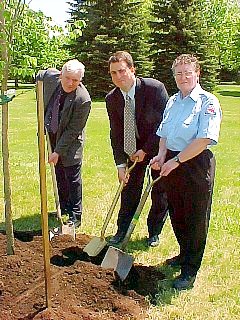Please don't take this personally, Sault Ste. Marie, but Ontario's horticulturalists have just presented you with a bastard elm tree.
The tree, formally known as a Celtis occidentalis but more commonly referred to as a bastard elm, hackberry, hagberry or sugarberry, was donated to us Thursday by the Ontario Horticultural Association (OHA).
Proudly planted in the Great Lakes Forestry Centre Arboretum, the gift commemorates the OHA's 96th annual provincial conference, which takes place later this month in Sault Ste. Marie.
Of course, no one at Thursday's presentation ceremony was calling it a bastard elm. They all delicately referred to the tree as a hackberry.
On hand for the presentation (shown, l. to r.) were Bill Meades, director of forest ecology for the Great Lakes Forestry Centre, Ward 2 Councillor Brady Irwin, and Judy Lewis, district director of the OHA's district 13.
Meades expressed delight with the gift, which replaces an earlier hackberry that died after it was transplanted to make room for a road through the arboretum.
All about hackberries
The hackberry tree is more commonly found in warmer climes. It grows widely in the United States, but in Canada is largely confined to Ontario's Carolinian Zone, that part of the province south of Highway 401.
Hackberries are known for their ability to tolerate a wide variety of soil types, but they particularly like places where limestone bedrock is either exposed or near the surface.
The hackberry is considered a member of the elm family, but is nonetheless resistant to Dutch Elm disease.
However, many hackberries suffer from a fungus infection that produces thick clusters of twigs called "witch's brooms."
Wood used in church pews
The fruit looks like purple cherries, is widely eaten by robins, pheasants, wild turkeys and other birds, and was used by the Dakota Indians to flavour meat.
The wood is soft and weak, and an 1858 collapse of a railroad bridge near Utica, New York was blamed on the use of hackberry instead of common elm, which looks remarkably similar.
The U.S. Hardwood Information Centre reports that most church pews in the Southern states are made of hackberry.
Ontario horticulturalists gather in the Sault
The Ontario Horticultural Association conference that the donated tree commemorates runs June 21, 22 and 23rd at the Best Western on Great Northern Road.
Presentations range from the purely practical (Ponds - Construction and Maintenance) to the paradoxical (Weeds - a Gardener's Best Friend).
For further information, contact Joanne at 256-1533.
Hackberry journalists
To receive free, real-time E-mail updates of SooToday.com's exclusive coverage of local news, just send an Email with "SUBSCRIBE" in the subject line to [email protected].
This free service is provided courtesy of the community-minded businesses whose advertisements appear on these pages.
